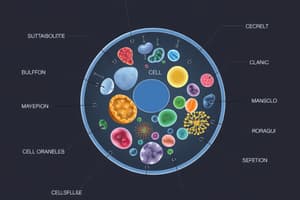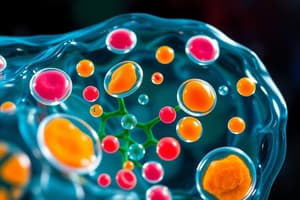Podcast
Questions and Answers
What are the three rules of cell theory?
What are the three rules of cell theory?
- All living things are composed of one or more cells. (correct)
- Cells must have a nucleus.
- Cells are the basic structure and function in living things. (correct)
- New cells are produced from existing cells. (correct)
Prokaryotic cells have a nucleus.
Prokaryotic cells have a nucleus.
False (B)
Eukaryotic cells do not have a nucleus.
Eukaryotic cells do not have a nucleus.
False (B)
What are the exceptions to cell theory?
What are the exceptions to cell theory?
What is a cell organelle?
What is a cell organelle?
Which of the following are functions of the nucleus?
Which of the following are functions of the nucleus?
What is the cytoplasm?
What is the cytoplasm?
What is the function of ER?
What is the function of ER?
Where are ribosomes located?
Where are ribosomes located?
What is the function of ribosomes?
What is the function of ribosomes?
What are Golgi Bodies known as?
What are Golgi Bodies known as?
What is the function of Golgi bodies?
What is the function of Golgi bodies?
What do vacuoles store?
What do vacuoles store?
What is the function of a mitochondria?
What is the function of a mitochondria?
What is the function of centrioles?
What is the function of centrioles?
Chloroplast is found in animal cells.
Chloroplast is found in animal cells.
What is the function of chloroplast?
What is the function of chloroplast?
What is another name for the cell membrane?
What is another name for the cell membrane?
What is the cell membrane?
What is the cell membrane?
The cell wall is found in animal cells.
The cell wall is found in animal cells.
What is the cell wall made of?
What is the cell wall made of?
What is the function of the cell wall?
What is the function of the cell wall?
What is passive transport?
What is passive transport?
What are the two types of passive transport?
What are the two types of passive transport?
What is the one type of active transport?
What is the one type of active transport?
What is diffusion?
What is diffusion?
What is Osmosis?
What is Osmosis?
What is facilitated diffusion?
What is facilitated diffusion?
What is the green pigment in chloroplasts?
What is the green pigment in chloroplasts?
Flashcards
What are the 3 rules of cell theory?
What are the 3 rules of cell theory?
All living things are composed of one or more cells. Cells are the basic structure and function in living things. New cells are produced from existing cells.
What is a Prokaryotic cell?
What is a Prokaryotic cell?
Prokaryotic cells do not have a nucleus.
What is a Eukaryotic cell?
What is a Eukaryotic cell?
Eukaryotic cells do have a nucleus. They also contain more organelles.
What are the Exceptions to the cell theory?
What are the Exceptions to the cell theory?
Signup and view all the flashcards
What is a cell Organelle?
What is a cell Organelle?
Signup and view all the flashcards
What is the function of the nucleus?
What is the function of the nucleus?
Signup and view all the flashcards
What is the cytoplasm?
What is the cytoplasm?
Signup and view all the flashcards
What is The difference between Rough and Smooth ER (Endoplasmic Reticulum)?
What is The difference between Rough and Smooth ER (Endoplasmic Reticulum)?
Signup and view all the flashcards
What is the function of ER (Endoplasmic Reticulum)?
What is the function of ER (Endoplasmic Reticulum)?
Signup and view all the flashcards
Where are Ribosomes located?
Where are Ribosomes located?
Signup and view all the flashcards
What is the function of Ribosomes?
What is the function of Ribosomes?
Signup and view all the flashcards
What are Golgi Bodies known as?
What are Golgi Bodies known as?
Signup and view all the flashcards
What is the function of Golgi bodies?
What is the function of Golgi bodies?
Signup and view all the flashcards
What is the function of Lysosomes?
What is the function of Lysosomes?
Signup and view all the flashcards
What do Vacuoles store?
What do Vacuoles store?
Signup and view all the flashcards
What is the function of a mitochondria?
What is the function of a mitochondria?
Signup and view all the flashcards
What is the function of Centrioles?
What is the function of Centrioles?
Signup and view all the flashcards
Where is Chloroplast found?
Where is Chloroplast found?
Signup and view all the flashcards
What is the function of Chloroplast?
What is the function of Chloroplast?
Signup and view all the flashcards
What is another name for the Cell Membrane?
What is another name for the Cell Membrane?
Signup and view all the flashcards
What is the cell membrane?
What is the cell membrane?
Signup and view all the flashcards
Where is the Cell Wall found?
Where is the Cell Wall found?
Signup and view all the flashcards
What is the Cell Wall made of?
What is the Cell Wall made of?
Signup and view all the flashcards
What is the function of the cell wall?
What is the function of the cell wall?
Signup and view all the flashcards
What is passive transport?
What is passive transport?
Signup and view all the flashcards
What are the 2 types of Passive transport?
What are the 2 types of Passive transport?
Signup and view all the flashcards
What is active transport?
What is active transport?
Signup and view all the flashcards
What is the 1 type of active transport?
What is the 1 type of active transport?
Signup and view all the flashcards
What is diffusion?
What is diffusion?
Signup and view all the flashcards
What is Osmosis?
What is Osmosis?
Signup and view all the flashcards
What is facilitated diffusion?
What is facilitated diffusion?
Signup and view all the flashcards
What is the green pigment in chloroplasts?
What is the green pigment in chloroplasts?
Signup and view all the flashcards
Study Notes
Cell Theory
- All living things are composed of one or more cells.
- Cells are the basic structural and functional units of living things.
- New cells are produced from existing cells.
Prokaryotic Cells
- Lack a nucleus.
Eukaryotic Cells
- Contain a nucleus.
- Have more organelles.
Exceptions to Cell Theory
- Viruses
- Mitochondria and chloroplasts (can reproduce independently)
- Origin of the first cell (unproven)
Cell Organelles
- Subunits within cells that aid in cell functions.
Nucleus
- Controls cell processes.
- Contains DNA.
Cytoplasm
- Watery substance between organelles inside the cell.
Endoplasmic Reticulum (ER)
- Transport system for proteins.
- Rough ER: studded with ribosomes, synthesizes proteins.
- Smooth ER: lacks ribosomes, synthesizes lipids.
Ribosomes
- Found on the ER or free-floating.
- Sites of protein synthesis.
Golgi Bodies/Apparatuses
- "Packaging and storing" center.
Golgi Body Function
- Receives, sorts, and packages proteins from the ER.
Lysosomes
- Contain enzymes to break down nutrients for cell use.
Vacuoles
- Store water, wastes, and nutrients.
Mitochondria
- Produce high-energy molecules (ATP) through cellular respiration.
Centrioles
- Aid in cell division (mitosis).
Chloroplasts
- Found only in plant cells.
Chloroplast Function
- Enable photosynthesis.
Cell Membrane (Plasma Membrane)
- Outer boundary of the cell.
- Regulates what enters and exits the cell (selectively permeable).
- Provides protection and support.
Cell Wall
- Found only in plant cells.
- Made of cellulose.
- Offers protection and support, with pores for material passage.
Passive Transport
- Movement of substances across the cell membrane without energy input.
Passive Transport Types
- Diffusion
- Facilitated diffusion
Active Transport
- Movement of substances across the cell membrane requiring energy (ATP).
Osmosis
- Type of active transport. (passive transport of water across a membrane).
Diffusion
- Movement of molecules from high to low concentration.
Facilitated Diffusion
- Movement of molecules from high to low concentration through protein channels.
Studying That Suits You
Use AI to generate personalized quizzes and flashcards to suit your learning preferences.
Description
Explore the fundamental concepts of cell theory, including the differences between prokaryotic and eukaryotic cells. This quiz covers key organelles, their functions, and exceptions to cell theory in detail. Test your knowledge on the building blocks of life!




